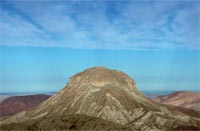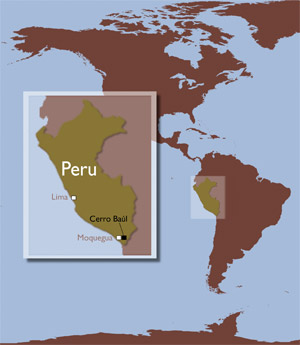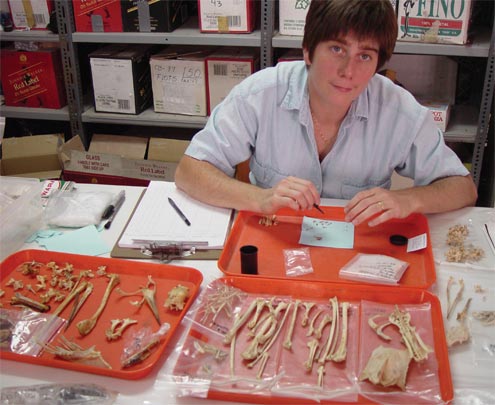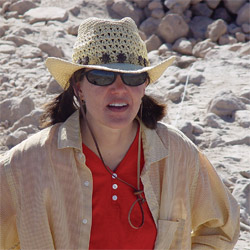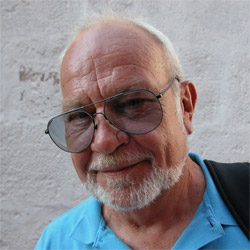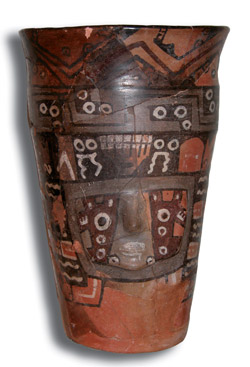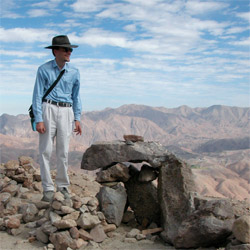|
|
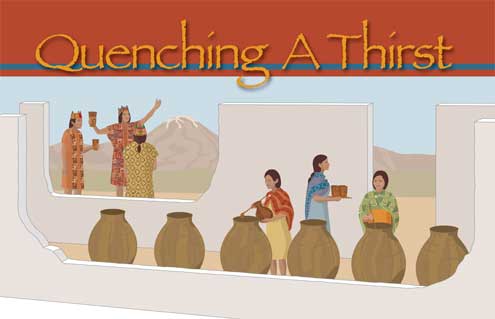 Researchers Seek To Understand How The Inca's Ancestors Lived, and Celebrated, Fourteen Centuries AgoBy Aaron Hoover
The 8,000-foot mesa in southern Peru known as Cerro Baśl is the last place you would expect to find a city. The ascent is steep and hazardous; the plateau barren and featureless. Most daunting, the mesa is bone dry, a desiccated stump of dirt and gravel bordering the Atacama, the world’s driest desert. Families can’t drink there, much less wash. And yet, more than 400 years before the Inca rose to dominance, the Wari did much more than settle the mesa. Peru’s largest civilization before the Inca, the Wari arrived at Baúl around 600 and built a city that housed 2,000 people and was bedecked with temples, gathering halls and luxurious cliff-top residences. They threw rollicking parties, drumming, dancing and perhaps pacifying dignitaries from regions menaced by their expansion. To keep the drinks coming, the Wari ran an industrial-scale brewery that could churn out weekly batches of hundreds of gallons of chicha, a beer-like concoction of fermented corn and a local pepper-like plant. Laborers had to haul every drop of water used in the brewery more than 1,000 feet up Baúl’s sheer slope from canals the Wari carved out in the valley.
Ten centuries after the Wari’s demise, their imperial showplace has been all but obliterated. Tourists visit Peru to take in the better-preserved and more accessible Incan ruins at Machu Pichu, Cusco and the Sacred Valley. But despite its continued status as a sacred “apu” for offerings to a mountain spirit, the mesa holds secrets not even the New Age community has divined. The Wari’s once-glitzy outpost at Baúl is Peru’s last great archaeological treasure to remain under active investigation — and the centerpiece of the longest-running archaeological program in that country’s history. Originated more than two decades ago by University of Florida anthropology Professor Mike Moseley, the $4 million program continues to upend conventional wisdom about pre-Incan times. “Twenty years of research has set us up to ask the most important questions — questions that we are only now beginning to answer,” says Ryan Williams, who earned his doctorate at UF under Moseley and now leads the Baúl expedition as assistant curator of anthropology at The Field Museum in Chicago.
Of Bones And PointsIt’s pointless to turn to the guidebooks for information about what some experts have called the “Masada of the Andes.” Instead, discovery begins with a 90-minute flight from Lima, Peru’s capital, to the port city of Tacna near the Chilean border. From Tacna it’s a two-hour cab ride north to the southern edge of the Andes. The cab passes through landscape so void of greenery it wrings barren of its meaning. The mountains are the size of the Appalachians but the color of milk chocolate. From a distance, their ridges look like gnarled roots at the base of a tree (hence “cerro,” Spanish for stump). Up close, their crumbly, dirt-and-gravel surface suggests nightmarish mounds of construction fill dirt. The terrain is so lifeless it’s a relief to reach Moquegua, a town of 55,000 and the project’s longtime base of operations. Moquegua reveals itself as hundreds of low-slung cement block homes smeared across a hill topped by a massive statue of Christ. With the morning sun burnishing the city, it seems at civilization’s edge, a fragile outpost in a dead world. The town’s only local source of water is an anemic river that originates far up in the Andes. Moquegua is so dry a native could grow up there without ever seeing rain.
Williams and Nash met at UF, where they earned their doctoral degrees and started a family. Erick, 15, Arica, 10, and Iain, 8, accompany the two to Moquegua every summer. The youths have an X-Box and other amenities of a U.S. childhood, but they speak passable Spanish and know the town like natives. The group arrives at the Museo Contisuyo, a handsome stone-faced building on a narrow street. The museum was founded at the request of Maria Preble, whose husband, Charles Preble, was CEO of the Southern Peru Copper Corporation. That company operated a mine near Moquegua and was a longtime sponsor of the Baúl research. deFrance and Nash head to the long, cluttered lab on the ground floor. deFrance works on piecing together the skeleton of a llama excavated within Baúl’s temple. The few missing bones, she says, suggest the llama has been ritually buried. Llamas and alpacas appear to be the dominant protein source for the Baúl nobles, although the researchers have also found remains of birds, several species of fish and guinea pig, or cuy, which remains a local delicacy, stewed or fried whole. Ritual burials are not unusual, deFrance says, but the animal “is our most complete llama offering.” At another table, Nash measures stone points and flakes. Nash says it appears different techniques were used to make tools recovered from the area, which suggests the crafters were from different regions or cultures. It’s possible the Wari intentionally mixed laborer populations as a means of social control, she says. “If you brought them from different regions, they might spend less time trying to revolt” because they didn’t understand each other’s languages and were suspicious of each other’s ways, she says. This morning’s work is just one tiny part of research during the summer of 2005, an off-year for excavation devoted instead to analysis and administration. Nash says she and most other archaeologists far prefer the excitement of excavation. But analysis — “always two or three years behind the digging” in Nash’s words — is as important as discovery. And although much has been learned, there’s plenty to do. Where Empires CollideSpecialists in Peruvian archaeology have long focused on the Inca, and for good reason. Arising after 1000 and thriving until devastated by smallpox introduced by European explorers in the 16th century, Incan dominion at its peak stretched more than 3,700 miles along the entire length of the Andes. It was the largest native state ever to arise in North or South America, and it left behind startling architecture, artifacts and cultural milestones.
The Inca were remarkably good at co-opting, rather than conquering, rival civilizations. But they didn’t acquire their political skills in a vacuum. Increasingly, archaeologists credit civilizations that preceded the Inca with originating their diplomatic savoir faire. The largest was probably that of the Wari. Perhaps spurred by the end of a long drought, the Wari first arose around 500 near Ayacucho, in Peru’s south-central highlands. The group expanded rapidly from that imperial capital, with Wari leaders establishing large citadels elsewhere. Cerro Baúl, more than 370 miles from Ayacucho, became the empire’s southernmost outpost. Agriculturalists and experts at terracing steep hillsides, the Wari dug an elaborate canal system to moisten the parched landscape. The remains of some canals remain visible today. Meanwhile, in roughly the same era, another empire, that of the Tiwanaku, arose to the south near Lake Titicaca in present-day Bolivia. The Tiwanaku occupied settlements near Baúl, the most important of which, Chen Chen and Omo, were about six miles away. The Wari and Tiwanaku couldn’t have been more different. The Tiwanaku were expert stone masons who built huge temples and farmed the altiplano, or high plane, while the Wari built barracks-style homes and specialized in terraces. With small Tiwanaku settlements, Yacango and Tumilacaere, within about a mile of Baúl, the Moquegua region is the only place where the two are known to have co-existed within sight of one another. That makes the area important for understanding how the empires influenced each other politically, economically and artistically. “We don’t know if the interaction was always peaceful, but it wasn’t necessarily rivalry in the way we think of it,” deFrance says. Indeed, the complexity of the Wari-Tiwanaku interaction is one of the key elements that makes the Baúl program so exciting, scholars say. “Most archaeologists would have expected that one of the two empires would have expanded and conquered the other, but that did not happen,” says Joyce Marcus, a professor of anthropology and curator of Latin American archaeology at the University of Michigan. “Instead they co-existed with religious tolerance … One thing we hope to learn from Moseley and Williams is why peace, tolerance and cultural exchanges characterized their interaction, rather than warfare.” Moseley kicked off research at Baúl in the early 1980s while working at The Field Museum. A plain-spoken scholar, his interest in Peru dates to research on coastal sites for his dissertation at Harvard. “I got down here and I saw that there was great archaeology, with well-preserved artifacts, and not many people around,” he says. “I’ve never left.” Moseley, who joined the UF faculty in 1984, quickly recognized Baúl’s uniqueness. One of only a handful of such flat-top mesas in the entire Andes, it is as imposing as it is inhospitable. A thousand years after the Wari’s demise, it remains a sacred site, home to a spirit revered by the native indigenous population as “El Señor de Cerro Baúl.” How and why the Wari came to occupy the summit, exactly what they built there and what their fate entailed were questions that begged to be answered.
Feasting, Drinking And Destruction Moseley was not the first to excavate Baúl — credit for that goes to one of his students, Robert Feldman of The Field Museum. Feldman turned the first earth in 1989. But Moseley, Williams, Feldman and another archaeologist, Johny Isla, produced the first extensive map of the city in 1993. Regular digs began in 1997, with field seasons in 1998, 2001, 2002 and 2004 and analysis continuing in between. Due to security concerns and the arduous hour-long climb to the Baúl summit, during excavations rotating crews of faculty, graduate students and technicians sleep atop Baúl in tents. The project has had several sponsors, including the G.A. Bruno Foundation, the Heinz Family Foundation and the National Science Foundation, with the Southern Peru Copper Corporation contributing $100,000 annually to the overall program for many years. The National Endowment for the Humanities is the latest sponsor, providing $68,500, enough for two more field seasons if the researchers raise additional matching funds. Although the digs have disturbed only five percent of the site, they have roughed out a remarkable settlement. At its prime, the archaeologists think the city center covered 30 acres, roughly half the mesa, with workers also living on parts of Baúl’s slope. There were one- and two-story buildings and a long plaza. As indicated by the discovery of grinding stones and clay molds, there were also stone-tool and ceramics workshops. Two temples gave the faithful a place to worship, while nobles celebrated at a feasting or dancing hall and lived at a magnificent flagstone-floored royal suite with a sweeping view of the countryside. With the exception of a raised platform and sunken plaza possibly used for speeches, almost none of the ruins are visible to the untrained eye today except during excavations. That’s because under Peruvian law, the archaeologists must rebury all ruins not under active investigation or post guards to protect them.
The finds are as notable for the questions they leave unanswered as for the details they provide. Like the Inca, the Wari probably used khipus, knotted strings, to record information, and none survive from Baúl. (Incan khipus, meanwhile, remain largely undeciphered.) As a result, archaeologists can’t even begin to discern the names of leaders, the details of important battles, key Wari holidays or other essentials often recorded in stone hieroglyphs of other cultures. Artistic representations, however, are more forthcoming. It is known, for example, that the Wari borrowed the Tiwanaku’s supreme deity, and it’s just possible that the Baúl-Mejía site may be where it happened. The deity — a front-faced figure that holds a staff in each hand — appears on the largest Wari keros reconstructed from fragments recovered from the site. Class divisions on the summit are clear, with expert masonry and spacious rooms characterizing the royal residences — and little except dark earth indicating the hearths of the less affluent. But other social matters such as male-female relationships are opaque. The discovery of nine thin copper and tin tupus, or shawl pins, in the brewery is a tantalizing suggestion that women served as the brewmasters. The archaeologists found the brewery in the early years of the investigation. But excavations in 2004 revealed the mammoth size of the operation, by far the largest, oldest brewery discovered in South America. One long, narrow room contained about a dozen large stones arrayed in a line to support large vats of brew. Another revealed remnants of corn and evidence of grinding. With at least twenty 25- to 35-gallon vats, the brewery could churn out at least 500 gallons at a time, enough for lots of guests to get very, very drunk. Moseley says the Wari used the brew to party and to pacify others, possibly including neighboring Tiwanaku nobles. There is evidence of a brewery and drinking atop Cerro Mejía, but it pales in comparison to the one on Baúl. “If you’re a ruler, you’re expected to be generous,” Moseley says. “You get to Mejía, they’re doing feasting and drinking, but we get to the super elites in the governor’s office on Baúl — it’s an industrial facility for drinking.” As silent as they are on some subjects, the ruins have given up one remarkably detailed and startling story — not about Baúl’s foundations but about its final days. Fragments pieced together into the drum and drinking mugs were found mostly atop a layer of charcoal, indicating the Wari probably smashed them after intentionally burning the brewery and feasting house. The mugs seem to be smashed in sets of four, with the largest mugs smashed last. Not only that, when the embers cooled, the Wari laid down atop them five necklaces made of semiprecious shells and stones. The Wari may have destroyed the important buildings to prevent newcomers from using and hence defiling them. Williams says ritualized destruction “may be related to religious thought on how one should leave a sacred building.” Why the Wari left Baúl remains one of its most beguiling mysteries. Excavations of the Tiwanaku settlements have found that the empire underwent a major upheaval about 1000, with many of the larger towns destroyed and people settling in smaller villages. It may be that internal politics fragmented the Tiwanaku empire, with those near Baúl switching allegiance to Wari and those farther south maintaining ties to Tiwanaku elites. That, in turn, could have led to other frictions. The answer may come in future years. The Baúl project sweeps across an arc of multiple sites from different eras as it seeks to grapple with climatological, seismic and environmental factors well beyond the purview of traditional archaeology. “We do climate, we do tectonics, we do ecology,” says Moseley, who was elected to the National Academy of Sciences in 2000 for his achievements in Andean research, including the Baúl work. “It’s really the synergies of a bunch of component studies that’s giving us this unique look at the long-term human evolution here.” A broad approach is one characteristic that sets the Baúl program apart, says Marcus, the Michigan archaeologist. While Inca scholars can turn to historic documents produced at the time of conquest, Moseley and Williams have been forced to be more creative. Yet this approach hasn’t compromised their science — quite the contrary. “What I have always liked and admired about them is that Moseley and Williams take no shortcuts. They are committed to the decades of meticulous excavation and fieldwork that it takes to address ‘the big problems,’” Marcus says. “… Both are so adept at combining the big picture with individual case studies that many archaeologists try to emulate them.” Pilgrim DilemmaThe rail-thin Williams, who favors a fedora and dark sunglasses in the field, is in charge of unspooling the rest of the story. But, nonwithstanding Hollywood, leading such a massive project involves much more than just excavation and discovery. Williams' greatest challenge may be preserving Baśl's remains from the indigenous people who journey to Baśl for "pagos," or offerings. The pilgrims' faith mixes traditional Catholicism with reverence for Pachamamma, or Earth Mother. As part of the ritual atop Baśl, many build clusters of rocks, or "maquetas," carefully arranged into patterns resembling homes and fields. It is considered bad luck to take rocks from one maqueta to build another. As a result, worshippers have steadily deconstructed what little remained, with the platform, for example, disappearing in the past decade before the archaeologists' eyes. The maqueta construction puts Williams in a delicate bind. On the one hand, he has no standing to keep out pilgrims, and wouldn't choose to disrupt a spiritual journey that dates back centuries anyway. On the other, the archaeologist in him yearns to preserve what's left. "You have to have at least some respect for local people's right to determine their own destiny," Williams says. "At the same time, you try to be a voice for protecting people's heritage. It's a difficult dilemma." Mike Moseley Ryan Williams
|
